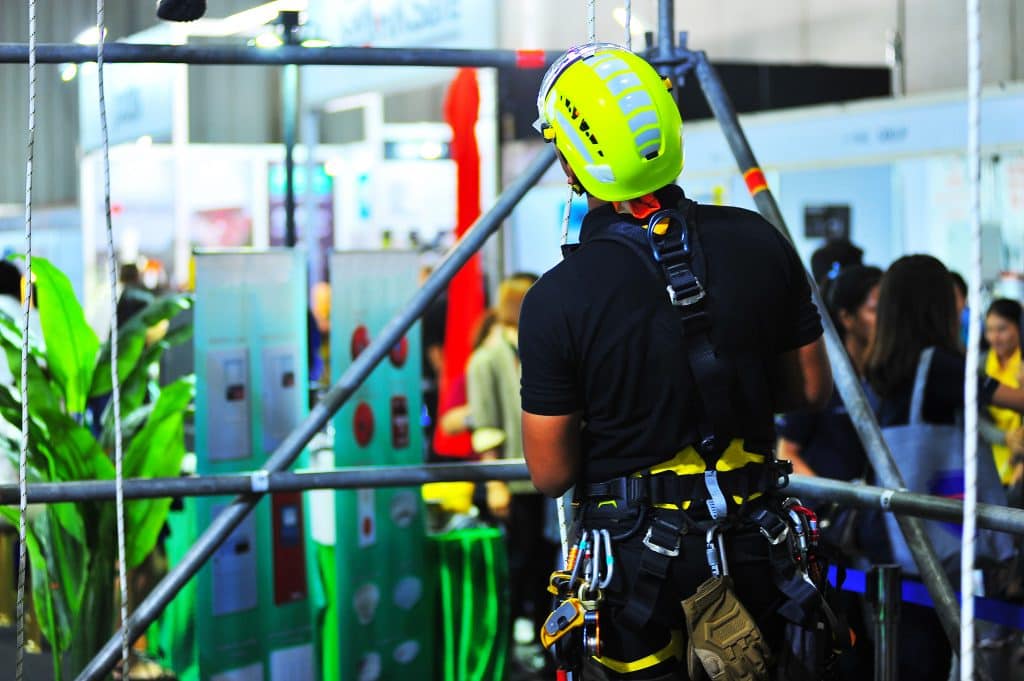What Are the Different Uses of Webbing in Safety Equipment?
With different fabrics offering particular benefits, the applications of safety webbing are extensive, so let’s break them down by industry as well as use (bear with us – the list is long):
- Automotive
- Airbag tethers
- Child restraint systems
- Side curtain reinforcement
- Aerospace
- Buoyancy aids
- Safety barriers
- Cargo restraint
- Air slides
- Cargo netting reinforcement webbing
- Marine
- Jackstays
- Harness assemblies
- Sail ties
- Toe straps on dinghies and sports boats
- Life jackets
- Buoyancy aids
- Flotation devices and PFDs (Personal Flotation Devices)
- Military
- Ejector seat components
- Parachutes
- Flight suits
- Medical
- Patient handling
- Medical PPE
- Emergency service
- Helmets
- Body armour
- Stretchers
- Rescue equipment
- Cycling
- Helmet chin straps and cradles
- Seat lap straps
- Equestrian
- Industrial
- PPE
- Cradles and chinstraps for hard hats
- Safety harnesses
- Breathing apparatus
- Emergency escape equipment
- Tool arrest systems
Which Fabrics Are Used in Safety Webbing and Why?
Polyester
Due to its versatility, the vast majority of the applications above will use polyester, ensuring performance to the required safety standards. Its excellent safety properties include:
- High tensile strength
- High UV resistance
- Water repellent (important for Marine applications)
- Chemical resistance
- Melting point of 260°C
- Low temperature resistance very good down to -100°C
- Low combustability
- Excellent colour retention (for safety messaging – see below)
Nylon
Nylon is also highly versatile and is often used for military webbing and outdoor applications. Its features and benefits include:
- High tensile strength
- Flame retardant
- UV resistance
- Chemical resistance (to dilute acids and common alkalis)
- High and low-temperature resistance
- Good abrasion resistance (ideal for applications where mechanical stress may occur)
Other Materials
Polypropylene is not as strong or UV resistant as nylon or polyester; however, it is light with a low absorption rate making it highly buoyant and suitable for use in some Marine safety applications.
For special performance applications where high strength, low modulus and flame retardant properties are paramount, Bowmer Bond can produce technical webbings from Technora®, Nomex®, Kevlar® and Dyneema® or equivalent fibres.
Finishing Touches
As well as the features and benefits listed above, we offer additional finishes and coating for our products to match your safety application, including:
- Anti-bacterial
- Water-repellent
- Flame-resistant / Fire-retardent
- Chemical resistant
- Stiffened
We also take into account the importance of safety messaging on our webbing reels and assemblies. Branding and messaging can be applied to narrow fabrics using techniques including the sublimation transfer process and Jacquard weaving, to ensure correct and safe use of equipment. Jacquard webbing has the advantage that it will not fade with time, and that the messaging stitched into the webbing will remain visible and stable, lasting the lifetime of the webbing itself.
Why Choose Safety Webbing from Bowmer Bond?
As a specialist webbing manufacturer based in the UK, Bowmer Bond has a wealth of experience and expertise in supplying webbing products to more than 25 countries worldwide. From a safety perspective, we guarantee the quality of our products thanks to rigiorous processes and testing (for example, break strain testing) based on ISO 9001.
We work closely with new and existing customers on development and product customisation to ensure we meet your specific requirements.
If you would like to find out more about our products and the markets we service, check out the rest of our website, give our experts a call on +44 (0) 1335 342244, or send us an enquiry using our contact form.
Posted 20th October 2022 by Bowmer Bond




